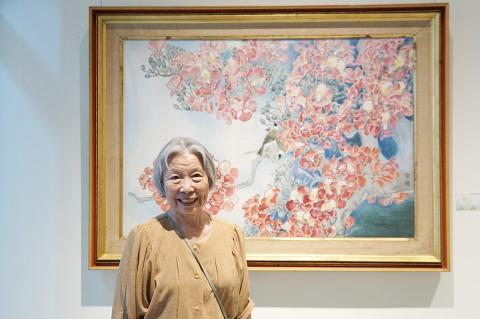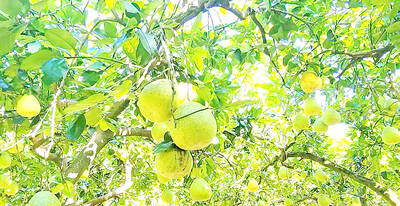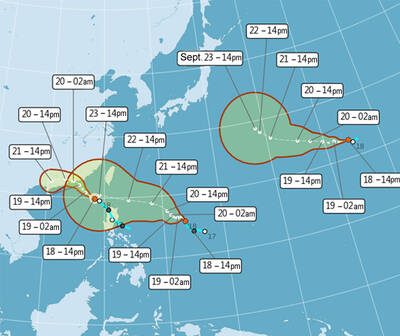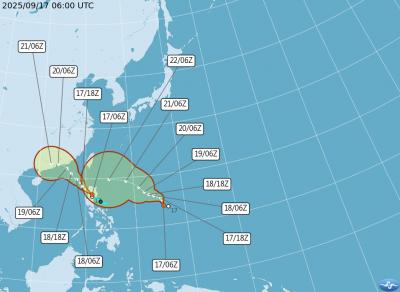Lin Hsing-hua (林星華) is one of the nation’s new female artists whose expertise is Eastern gouache painting.
A student of artist Lin Chih-chu (林之助) — dubbed the father of Eastern gouache painting in Taiwan — Lin Hsing-hua said she swore to him that she would never give up the style after Lin Chih-chu told her that his female students tended to quit.
Born in Taichung in 1932, Lin Hsing-hua did not take art lessons as a child, but learned how to make clothes at Taichung Home Economics and Commercial High School.

Photo: Ho Tsung-han, Taipei Times
She impressed her teachers by being able to draw near-perfect lines freehand, to the point where one teacher asked her to make a suit for a child.
At the National Taichung University of Education, Lin Hsing-hua became Lin Chih-chu’s student.
Lin Hsing-hua said that he first taught her how sketch and paint in watercolors, but noting her special interest in painting, he began tutoring her on the basics of Eastern gouache painting — including how to prepare the paper, sketch and apply color — outside of class.
Eastern gouache painting was introduced to Taiwan during the Japanese colonial period and is often referred to as nihonga, a Japanese painting style, to distinguish it from Western styles.
The paint is made by mixing glue with pigments made of minerals, soil, metals or other materials.
“The beauty of Eastern gouache lies in its color,” Lin Hsing-hua said, adding that it does not fade.
“Once it is painted, it is preserved forever,” she said.
Her oldest brother would mail her pigments from Tokyo, where he worked, she said, adding that he would spend thousands of New Taiwan dollars on each package.
The post office mistook one such package for drugs and would not let her take it, she said.
It was powdered oyster shells — a relatively inexpensive pigment-making material, she said.
Lin Hsing-hua said that Lin Chih-chu cared greatly about painting real-life objects, teaching her to pay attention to details such as the direction in which a morning glory plant was growing.
An artist must be familiar with the structure and characteristics of the subject they are painting, be it a flower or a bird, otherwise, an expert could easily spot mistakes, she said.
To paint birds properly, Lin Hsing-hua said she kept pet birds — including a pheasant — to observe their wings and feet.
The Lin Chih-chu Memorial museum near the Willow River (柳川) in Taichung is where she learned to paint.
While a junior at the university, her Red Multiflora Rose was selected to be displayed in the now-defunct Taiwan Provincial Fine Arts Exhibition.
She received awards at that exhibition, the Taiwan Provincial Employees’ and Teachers’ Art Exhibition and the Taiyang Art Exhibition.
Unfortunately, her winning works stayed with the organizers, she said, adding that their whereabouts are unknown.
Lin Chih-chu trusted her, she said, adding that while he asked to see the drafts of other students’ work multiple times throughout the creative process, she only showed him her works after they had been exhibited, as she was afraid that her work would become too similar to his.
Lin Chih-chu’s wife took great care of her, often asking her to stay for dinner after class, she said.
When Lin Chih-chu founded the Taiwan Gluepainting Association in 1983, she served as a member of the supervisory committee.
During the Martial Law era, accomplished students were required to join the Chinese Nationalist Party (KMT), she said.
Her younger brother Lin Hsin-chih (林心智) pursued a doctoral degree in child psychology at the University of Georgia in the US, but after he completed his studies, the KMT would not allow him to return to Taiwan because he was not a member of the party, she said, adding that he was not allowed to return even when their mother passed away.
Lin Hung-hsuan (林弘宣), her other younger brother, who was the executive secretary of Formosa Magazine’s (美麗島雜誌) service center, was jailed on Green Island (綠島) for many years following the Kaohsiung Incident, she said, adding that he was not released until he was diagnosed with lymphoma.
The Kaohsiung Incident, also known as the Formosa Incident, took place on Dec. 10, 1979, when the then-KMT government cracked down and imprisoned participants in an anti-government parade organized by the magazine.
For herself, she said most of her abstract paintings were created during the Martial Law era, but added that as the paintings could be interpreted according to each person’s taste, she avoided trouble.
For example, a painting titled Work Hard (打拚) on the surface represented the labor of the people, when in fact it had a hidden message that people were trapped, she said.

NEW AGREEMENT: Malaysia approved imports last year after nearly two years of negotiations and inspections to meet quarantine requirements, officials said Up to 3.6 tonnes of pomeloes from Taiwan cleared Malaysian customs on Friday, in the first shipment of Taiwanese pomeloes to Malaysia. Taiwan-grown pomeloes are popular in domestic and overseas markets for their tender and juicy taste, the Ministry of Agriculture’s Animal and Plant Health Inspection Agency said. The fruit is already exported to Japan, Canada, Hong Kong, Singapore and the Philippines, it added. The agency began applying for access to the Malaysian market in 2023, compiling data on climate suitability, pests and diseases, and post-harvest handling, while also engaging in nearly two years of negotiations with Malaysian authorities and submitting supplementary

PEAK MONTHS: Data showed that on average 25 to 27 typhoons formed in the Pacific and South China seas annually, with about four forming per month in July and October One of three tropical depressions in the Pacific strengthened into a typhoon yesterday afternoon, while two others are expected to become typhoons by today, Central Weather Administration (CWA) forecaster Lee Ming-hsiang (李名翔) said yesterday. The outer circulation of Tropical Depression No. 20, now Typhoon Mitag, has brought light rain to Hualien, Taitung and areas in the south, Lee said, adding that as of 2pm yesterday, Mitag was moving west-northwest at 16kph, but is not expected to directly affect Taiwan. It was possible that Tropical Depression No. 21 would become a typhoon as soon as last night, he said. It was moving in a

One of two tropical depressions that formed offshore this morning could turn into a moderate typhoon by the weekend, the Central Weather Administration (CWA) said today. Tropical Depression No. 21 formed at 8am about 1,850km off the southeast coast, CWA forecaster Lee Meng-hsuan (李孟軒) said. It is expected to move in a northwesterly direction as it continues building momentum, possibly intensifying into Typhoon Mitag this weekend, she added. The radius of the storm is expected to reach almost 200km, she said. It is expected to approach southeast of Taiwan on Monday and pass through the Bashi Channel between Tuesday and Wednesday,

Tigerair Taiwan and China Airlines (CAL) today announced that several international flights were canceled or rescheduled due to Typhoon Ragasa. The Central Weather Administration (CWA) has maintained sea and land warnings for the typhoon. Its storm circle reached the Hengchun Peninsula (恆春半島) on Taiwan's southern tip at 11am today. Tigerair Taiwan said it canceled Monday's IT551/IT552 Taoyuan-Da Nang, IT606/IT607 Taoyuan-Busan and IT602 Taoyuan-Seoul Incheon flights. Tomorrow, cancelations include IT603 Seoul Incheon-Taoyuan, as well as flights between Taoyuan and Sapporo, Osaka, Tokyo Narita, Okinawa, Fukuoka, Saga, Tokyo Haneda, Nagoya, Asahikawa and Jeju. On Wednesday, the IT321/IT322 Kaohsiung-Macau round-trip would also be canceled. CAL announced that today's